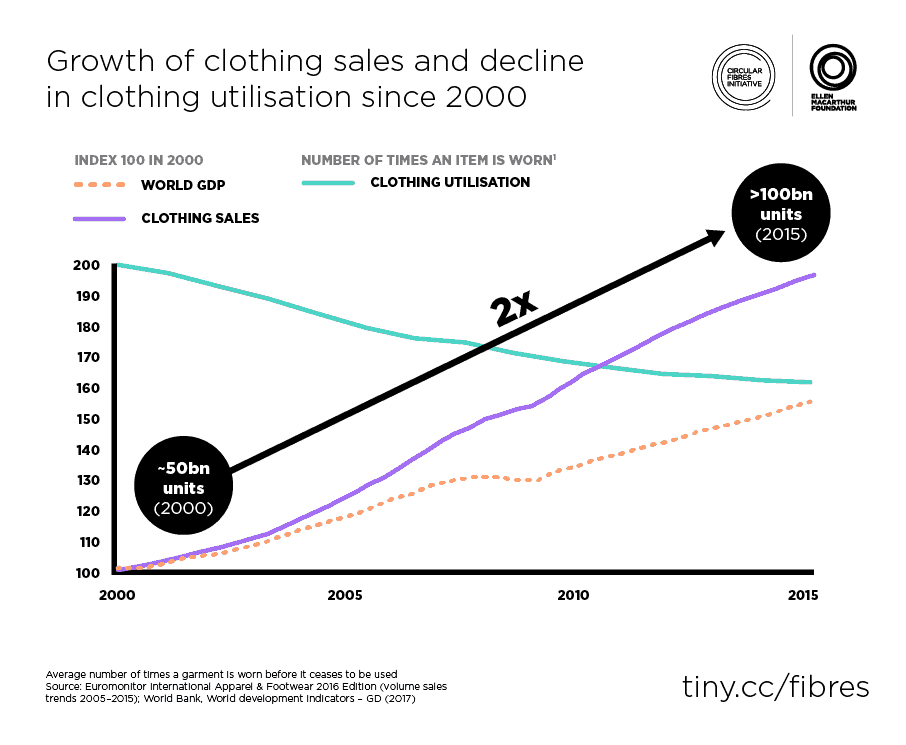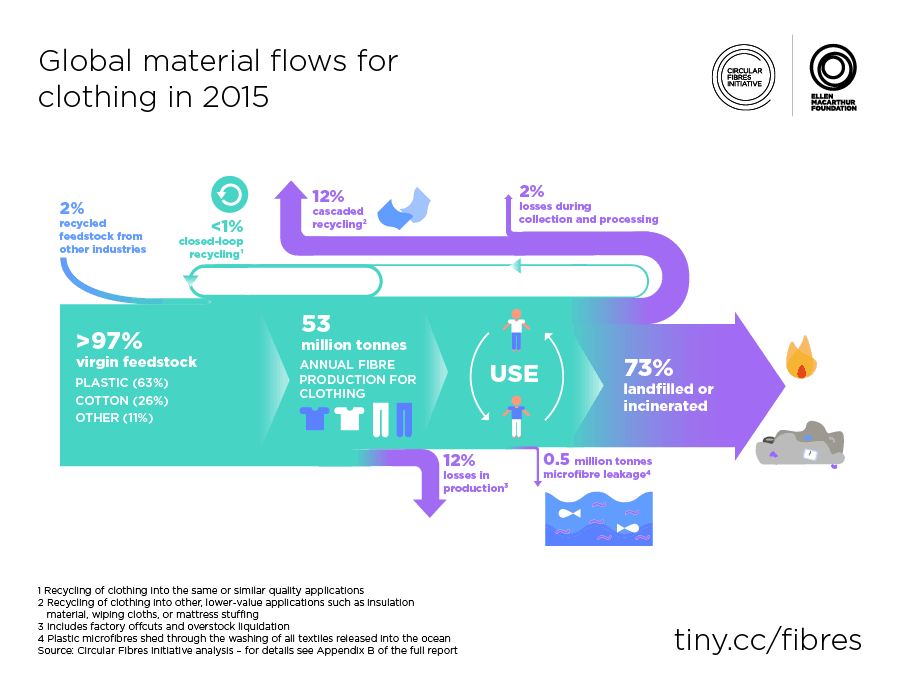News reports about the 2019 Copenhagen Fashion Summit (May 15-16, 2019) highlighted current efforts by the French government to encourage fashion companies to establish sustainability goals for the industry. French President Emmanuel Macron has appointed Francois-Henri Pinault, CEO of Kering SA, to lead the charge. This is part of increasing concern around the world on the issues of waste and waste management. Initiatives like the one in France, and others around the world, are also shifting focus from our past of linear supply chains to a future of circular supply chains.
Putting things in context
According to the World Bank Group’s “What A Waste 2.0: A Global Snapshot of Solid Waste Management to 2050”:
- In 2016, 2.01 billion metric tonnes (4,431.3 billion pounds) of municipal solid waste was generated globally. If nothing changes, this is expected to increase to 3.4 billion metric tonnes (7,495.7 billion pounds) by 2050.
- Food and green waste make up about 50 percent of waste in low-income and middle-income countries. In high-income countries, this proportion is 32 percent.
- Recyclables – paper, cardboard, plastic, metal and glass, make up about 16 percent of the waste stream in low-income countries, and up to as much as 50 percent in high-income countries.
Assuming a full garbage truck weighs 23 metric tonnes or 50,000 pounds, this means that global waste produced in 2016 was the equivalent of about 87,391,304 garbage trucks per year, or 239,428 garbage trucks per day. If nothing changes, in 2050, annual global waste will be the equivalent of 147,826,087 trucks, or 405,003 garbage trucks per day.
What are the biggest culprits in post-consumer waste?
Fashion, apparel and textiles are attracting a lot of attention. The following data and information in Figure 1-Figure 6 below, from The Ellen MacArthur Foundation’s “A New Textiles Economy: Redesigning Fashion’s Future” report proves instructive. In summary, the problem is growing and solving it will require a new way of thinking, and concerted collaboration to create systemic solutions rather than isolated solutions.






Plastic waste has also been attracting a lot of attention. Here too, The Ellen MacArthur Foundation’s New Plastics Economy initiative is uniting companies, governments and multilateral organizations to curtail and reverse the adverse impact plastic pollution is having on the world. To properly understand the problem posed by plastics, consider that reports suggest that popular everyday items made from plastic can take anywhere from 10 to 5,000 years to decompose through biodegradation. Figures 7 and 8 below put things in further context.


The gravity of the problem posed by plastics especially is captured by media reports:
- May 2019 – National Geographic reported that “more than 180 nations agreed in Geneva to add mixed plastic scrap to the Basel Convention, the treaty that controls the international movement of hazardous waste.” This has become an issue of growing international concern ever since China stopped buying non-industrial plastic waste in 2018 – China is the biggest importer in the $200 billion global market for non-industrial plastic waste. It is becoming increasingly difficult for wealthy countries to export their trash to poor countries.
- May 2019 – National Geographic and CNN reported that plastic debris was discovered at the bottom of the Mariana Trench, at a reported depth of 35,849 feet (6.79 miles) or 10,927 meters (10.93 kilometers).
- March 2019 – The New York Times and the Washington Post reported that a dead whale was found on a beach in the Philippines with 88 pounds (39.92 kilograms) of plastic in its stomach.
News media reporting and statistics on other categories of waste paint an equally damning picture. For example, according to the United Nations’ Food and Agriculture Organization, about one-third of the food produced in the world goes to waste every year.
So, what’s being done about this problem?
Companies, national governments and multilateral organizations are teaming up to try to tackle the problems posed by increasing amounts of waste. For example, news reports about the 2019 Copenhagen Fashion Summit also highlighted Nike’s creation of an open source design guide aimed at nudging the fashion industry towards a future of circular and sustainable supply chains.
There are a few difficult problems in relation to the creation of circular and sustainable supply chains:
- First, there is a dearth of voices from supply chain logistics in the discussions so far. How we move post-consumer waste to sorting and recycling centers will be a key component of creating circular supply chains.
- Second, a clean and sustainable environment fits the definition of a public good. Therefore, efforts to build circular supply chains could very easily be susceptible to the free-rider problem unless political and economic structures are put in place to prevent that from happening.
- Third, the success of circular and sustainable supply chains will rest on big behavioral changes for people all over the world – from a linear culture that glorifies consumption and generates a great deal of waste, to a cyclical culture that minimizes unnecessary consumption, minimizes waste and maximizes sustainability and the reuse of products.
On the bright side, there are several startups in different industries creating innovations to tackle the problem of waste. Social movements like #FridaysForFuture could potentially gain strength and drive the tougher political action that may be required to spur private industry into taking more concrete steps to bring circular supply chains out of the lab and into the real world, at scale.







